-- Published: Monday, 30 October 2017 | Print | Disqus
By John Mauldin
The Fragmentation of Society
The Future of Work
The End of Cancer
Angst in America
Denver, Lugano, and Hong Kong
Lately, my life has been completely packed with speeches, meetings, and in-depth, often lengthy, conversations. Plus ongoing research and writing, of course. It all culminated Thursday afternoon at the beginning of a business meeting with the leadership team from a firm that will become a significant new business partner. At the very beginning of the meeting, the head of the firm leaned over to me and asked, “What’s on the top of your mind? What are you thinking about?” The previous night we had a small group of about 15 people in my living room after dinner, and the question was similar, “What keeps you up at night?”
It has become an emotional question for me, because the answer does not come easily, is complex, and can be more than a little unsettling. It is, however, evolving out of the research and writing I’m doing on my new book, The Age of Transformation. Whether audiences and readers agree with my answer or not, it is not a feel-good message, which is somewhat frustrating because I’m the biggest long-term optimist in the room. But I acknowledge that what I am talking about suggests that the ride between today and the long-term happy ending is going to be more than a bit bumpy.
This week’s letter is going to be a passionate summary of my answer. In form, it will be something like a conversation between you and me, sitting in your living room or mine, or in a restaurant, maybe sipping an adult beverage, thinking through the future together, and wondering at how the world is transforming in front of our eyes.
In part, the impetus for this letter was a video I did with Patrick Cox last week, one in a four-part series that Patrick is doing called “Riding the Gray Tsunami.” We had a candid conversation about the future that lasted an hour, though our outstanding moderator and editor Jonathan Roth, one of our team members, will likely edit it to about 30 minutes. Patrick’s other guests will be Dr. Mike Roizen, the chief wellness officer at the Cleveland Clinic; Aubrey de Grey, the chief science officer of SENS Research Foundation and one of the true experts on longevity science; and finally, our friend Jim Mellon, self-made British billionaire and avid biotech investor. You can sign up to participate here. You really don’t want to miss this. Now let’s jump to the letter.
The Fragmentation of Society
In the interest of brevity, let’s take it is a given that we’re going to see massive technological change in the next 20 years. In fact, we will see more change – and improvement – in the next 20 years than we’ve seen in the last hundred. Think where we were 100 years ago and how much has changed since then. That much and more is going to happen in the next two decades. Global society really is going to transform that fast.
Let’s start with some good news. In 1820 some 94% of the world’s population lived in extreme poverty. By 1990 the figure was 35%, and in 2015 it was just 9.6%. Forty percent of those who remain impoverished live in just two countries, Nigeria and India, both of which are growing rapidly and will see their extreme poverty significantly decrease in the next 20 years.
There is research to show that, on a global basis, the poor are getting richer faster than any other group. However, if you look around the US or Europe, that is not the conclusion you come to. But Africa or Asia? Absolutely. Let’s be clear: The Industrial Age and free-market capitalism, for all of its bumps and warts, has lifted more people out of poverty and extended more lives than has any other single development. The collapse of communism has been a great boon to humanity (even if it is still talked about favorably in Western universities).
Because of where the emerging-market economies are in the development cycle, they have the potential for vast, rapid improvement in the lives of their people. But most of my readers do not live in the emerging markets. We live in the developed markets; and here, some of the outcomes of the Age of Transformation will not be so comfortable. Let’s start with this chart (hat tip, Downtown Josh Brown).
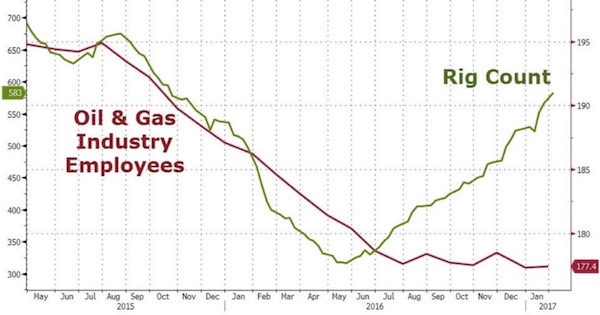
Obviously, the rig count in US oilfields is rising rapidly – no surprise there. But distressingly, the number of oilfield workers is continuing to fall. How can this be?
There is an answer to that conundrum in the long article that is the source of this chart and others I’ll use later. There is a new robotic machine called an Iron Roughneck that reduces the human labor required to connect pipe from a crew of 20 down to a crew of five. And those jobs were quite high-paying. Here’s a picture of this new robotic roughneck. Fifteen workers per site at well over $100,000 a year each? Does that machine look like it cost more than a few million? I bet it amortizes pretty quickly, and that’s why it is being rapidly adopted.
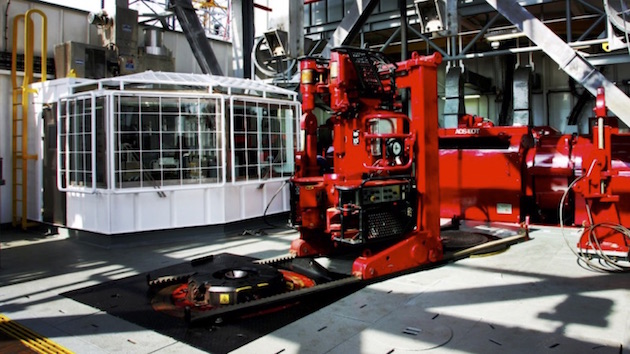
Now look back at the chart. The amazing thing is that this transformation happened in two years; it didn’t take a generation or even half a generation. You were an oilfield worker with what you thought was potentially a lifetime of steady, well-paying – if dangerous, nasty, and dirty – work. And then BOOM! The jobs just simply disappeared. Your on-the-job experience doesn’t translate to any other industries very easily, and now you and your family are on the skids.
I could actually spend this entire letter talking about the amazing transformation of the oilfield. Oil production is now a technology business. Computers and artificial intelligence are used in abundance in the oilfield. Future wells are going to be a magnitude more productive and less expensive. There are oilfield operators here in Dallas running around with pro formas, raising money, talking about how they can do very well at $40 and even $30 per barrel. And with oil at $54 and looking as though it could well go to $60, they are raising money and punching holes. Just with fewer workers.
From the report on the Iron Roughneck we get the following alarming quote. (Note that the report is full of links to academic research. While I don’t like the author’s conclusions, his work is at least well researched).
A landmark 2017 study [dismal reading – John] even looked at the impact of just industrial robots on jobs from 1993 to 2007 and found that every new robot replaced around 5.6 workers, and every additional robot per 1,000 workers reduced the percentage of the total population employed by 0.34% and also reduced wages by 0.5%. During that 14-year period of time, the number of industrial robots quadrupled and between 360,000 and 670,000 jobs were erased. And as the authors [Daron Acemoglu and Pascual Restrepo] noted, “Interestingly, and perhaps surprisingly, we do not find positive and offsetting employment gains in any occupation or education groups.” In other words, the jobs were not replaced with new jobs.
It’s expected that our industrial robot workforce will quadruple again by 2025 [more troubling MIT research – John] to 7 robots per 1,000 workers. (In Toledo and Detroit it’s already 9 robots per 1,000 workers.) Using Acemoglu’s and Restropo’s findings, that translates to a loss of up to 3.4 million jobs by 2025, alongside depressed wage growth of up to 2.6%, and a drop in the employment-to-population ratio of up to 1.76 percentage points. Remember, we’re talking about industrial robots only, not all robots, and not any software, especially not AI. So what we can expect from all technology combined is undoubtedly larger than the above estimates.
Automation has been happening right under everyone’s noses, but people are only beginning to really talk about the potential future dangers of automation reducing the incomes of large percentages of the population. In the US, the most-cited estimate is the loss of half of all existing jobs by the early 2030s.
You can find people who estimate that technology will eliminate as many as two billion jobs, while also creating a large number of jobs – but nowhere near as fast. I don’t buy those extreme estimates, as I think they amount to sensationalism, but if you want to predict 30 to 40 million jobs lost in the US by the middle of the 2030s (that’s 17 years from now), I’m not going to argue with you. How many jobs will be created? We’ll get to that in a minute.
The Future of Work
People frequently talk about the loss of trucking and taxi jobs that will result from the automation of driving. RethinkX, in a 77-page report, concludes that 90% of all driving in the US will be TaaS (transportation as a service) by 2030, although that will utilize only 60% of the cars. The good news is that the average family will save $5,600 per year in transportation costs, keeping an extra $1 trillion per year in Americans’ pockets. Think of all the time that will be freed for activities other than driving, not to mention the traffic jams that will be reduced. The authors believe that freeing time now spent commuting to work, plus faster transport times, will lead to an increase in GDP of between $500 million to as much as $2.5 trillion. Public sector budgets will benefit because highway infrastructure costs will fall, and vast amounts of land will be freed from parking lots and publicly owned right-of-way properties next to highways. Of course, governments will lose as much as $50 billion in gasoline taxes as we shift from internal combustion engines to electric and other alternative forms of power systems.
The really bad news is that a lot of people will lose their incomes.
The report projects that the adoption of TaaS will come about in typical technological adoption fashion: slowly and then seemingly all at once. The authors talk about the end of individual car ownership. Why would you own a car if it was far cheaper and more convenient just to pick one up via an app on your phone? Not owning a vehicle frees a lot of garage and parking space and might even eliminate the hassle of picking up your kids and getting them to and from their various activities. Of course, the system will work much more effectively in urban and suburban areas than in the rural world.
And it is not just the six million taxi and truck driver jobs that are threatened. Automated driving will save some 30,000 lives per year just in the US, which is something to be applauded. But it will also dramatically decrease the number of people going to emergency rooms from automobile wrecks, reducing the need for healthcare workers. Since cars won’t be in wrecks, the number of people required to repair them will be radically reduced. There are 228,000 auto repair shops in the country, employing some 647,000 workers (at a minimum – data from BLS). When a new car will last for one million miles and have fewer than 30 moving parts, those auto repair people are going to be like the Maytag repairman in the commercials of my youth: very lonely and increasingly unemployed.
If driving is TaaS, then automobile dealerships are in trouble, as are most car salesmen and the 66,000 people who work in automotive parts and accessories stores. What about auto insurance salesmen? And all the gas stations that will not be needed? (When an automated car gets low on electricity, it will simply pull into a spot and replug – automatically, of course, aided by robotics.)
The US auto industry employs 1.25 million people directly and another 7.25 million indirectly. Not all driving jobs will be lost, but the authors estimate that around 5 million will be, with a reduction in national income of $200 billion.
And if we need fewer cars? That shift would put a lot of automotive manufacturing companies and their workers under severe strain. I’m not certain how the authors arrived at the number, but they estimate new-vehicle annual unit sales will drop by 70% by 2030, to around 5.6 million vehicles versus the 18 million that will be sold in 2020. Ugh. If we actually do see wholesale conversion to electric vehicles, US oil demand for passenger road transport could drop by 90% or more. Oil production companies may need to figure out how to make life work at $25 per barrel, if that’s the case.
Personally, I think the report is a little over the top. (Well, maybe more than a little.) But if they stretch those projection figures to 2035 or 2040? Totally in the ballpark. And frankly, as I will note in a few paragraphs, whether it’s 2030, 2035, or 2040, the change will seem like it came overnight and totally out of left field – especially for the workers who no longer have work.
The End of Cancer
I was talking with my friend Dr. Ray Takigiku, chief executive and chief scientist of Bexion Pharmaceuticals. The company is now 15 months into a phase I trial to determine the safety of a drug called BXQ-350, which is basically a full-on silver bullet for mass-tumor cancers. It has so far been a small trial in four medical research universities, with a limited but growing number of patients who have pancreatic cancer and brain tumors. The results have been very promising. Ray told me about one patient at the University of New Mexico who has a very rare form of cancer and who was given the drug. This is a cancer for which there is no treatment – it’s basically a death sentence. It occurs in adults but more frequently in children. Ray was initially concerned about treating this patient, as the study is about safety and you really don’t want to have any issues associated with a safety trial. But the patient’s doctor talked him into proceeding, and they began to administer the drug. It hasn’t been very long, but the patient is improving, and the cancer is regressing. He had lost partial use of his right side but is now walking and using that side again.
Because it’s a phase I trial, we don’t really have much information about how effective the drug is, apart from anecdotes; and distressingly, the researchers must sometimes stop administering the drug because that’s part of the required protocol. The rules simply want to make me pull my hair out.
In the US, one million people per year get cancer, and half a million die. Those are ugly statistics, but they could change drastically within less than 10 years. Cancer could become a nuisance rather than a threat to life. I lose more and more friends every year to cancer. We all do. I will be so glad if that stops. So will you.
Full disclosure: I was a first-round investor in Bexion, and so I have a strong home-field bias in wanting BXQ-350 to succeed, but the reality is that its success will be extraordinarily good for humanity. And frankly, one of the main risks to my investment is not that the drug won’t actually work, but that any of several other companies that Patrick Cox and I are looking at will actually come up with a drug that is cheaper, better, and faster. Or maybe, as in treating AIDS, you end up with a cocktail of drugs to fight cancer.
One way or another, cancer is going to go the way of measles and polio. You’ll be diagnosed by means of a simple blood test that will be part of your annual medical checkup, and you’ll be informed if you have cancer. Next you will undergo further tests to determine what type. And then, whatever the therapy is, it is likely that you will simply go to your doctor’s office for regular treatments. In the case of Bexion’s drug, treatment will (hopefully) amount to a few months or less of three visits per week, no side effects, and your cancer goes away. That is the extrapolation from mouse studies. We’ll know more after phase II studies are underway sometime next year. Since it is now public information, I can mention that John McCain will be given access to this drug at the University of New Mexico Comprehensive Cancer Center. Randomly, McCain has one of the types of cancer that the phase 1 trial has focused on. And he also actually qualifies for the trial (which is not easy to do). With all Americans, I wish him the best.
But let’s think for a minute about the impact of the success of a drug of this type beyond the many lives that will be saved and the significant reduction of pain and suffering. I couldn’t determine the number of healthcare workers specifically associated with the treatment of cancer, but it has to be in the hundreds of thousands, and they have relatively high-paying jobs. Then there are all the hospital beds filled by cancer patients – easily many tens of thousands. Plus all the ancillary workers that are associated with the care and welfare of cancer patients. The good news is that with the rising need for healthcare workers, those workers will be able to relatively quickly moved to an associated field. And let’s not forget the estimate Kyle Bass gave me, that at least $500 billion of market cap in big Pharma will be destroyed by a cure for cancer.
So there are just two examples of major disruptions to employment that will be caused by near-future technological change. We haven’t even gotten into the brick-and-mortar retail jobs that online sales firms like Amazon are taking away. And warehouse workers? The list could go on and on of whole job classifications that are endangered species. These changes are going to disrupt our lives and the social cohesion of our country. And of course these shifts are coming not just in the US, but in the entire developed world. And even technology centers in the developing world are going to find themselves at risk of employment dislocations.
Just so that I don’t appear to be a total Gloomy Gus, let me quickly note that the very technologies that are destroying job are also going to result in tens of millions of new and in many cases better jobs. Many of them will be high-paying, more life-fulfilling, and far less dangerous than the occupations they replace. I’ll write a letter in the near future in which I’ll talk about where those tens of millions of new jobs will hopefully come from.
The glib answer to the question, “Where will the jobs come from?” has always been “I don’t know, but they will.” That is what has always happened in the past. We went from 80% of laborers working on the farm in the 1800s at barely subsistence-level incomes to 2% producing far more food today. As these farm workers became redundant, they moved to where the jobs were. And with a lot of ups and downs, we managed over time to find jobs for nearly everyone. But that transition took place over 200+ years – 10 generations. There was time for people to adjust and for markets to adapt. Even when whole industries appeared and then disappeared again, it happened over generations. Everybody bemoans the loss of US manufacturing jobs, but few realize that we are producing almost as much as we ever have – just with fewer people. And this trend will continue. More production, with fewer workers. Just like we see in the oilfields.
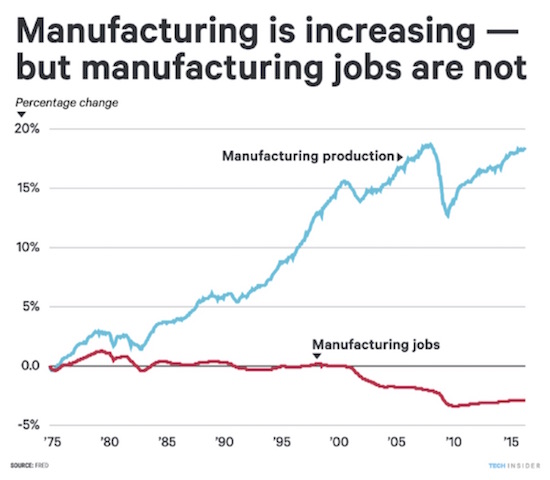
The transformations I am talking about are going to happen in one half a generation, or at the most a full generation. That is not much time for adjustment, especially for a country like the United States where 69% of families have less than $1,000 in savings. (I have seen the figure quoted that 47% have less than $400.) That is not enough to deal with the loss of your job.
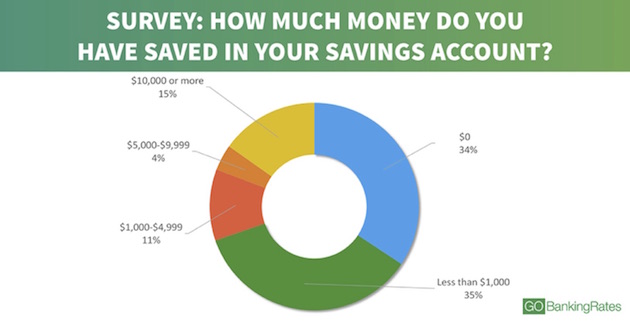
The classic Republican answer to this problem is that we need to unleash the entrepreneurial tide in the United States that has been dammed up by bureaucracy and excessive taxation. And there is a point to that. But for whatever reason – and this is a topic for another letter (and it’s one I have addressed in the past) – for the past five or six years the country has had more firms close than be created, and for the first time in our history.
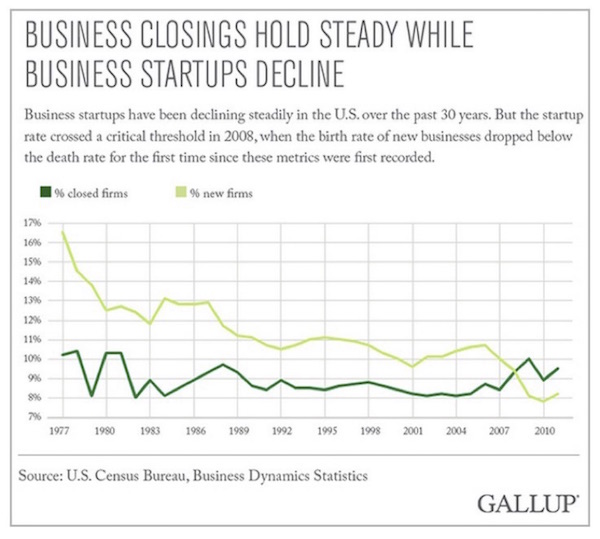
Angst in America
Let me emphasize that ultimately we’ll arrive at a very happy ending. Our heroes and heroines will walk off into the sunset, holding hands and living happily ever after. Literally living happily ever after, because of the new life-extension technologies that are just around the corner in a world of amazing abundance and ever-cheaper products, with even greater lifestyles than today’s. Flying to the Moon and Mars…
The problem is not the happy ending. The problem is the transition, which is going to be bumpy and frustrating and potentially divisive. I’m going to show you three graphs from Pew Research. Analysts have been conducting studies (see people-press.org/interactives/political-polarization-1994-2017/ and pewresearch.org/fact-tank/2017/10/05/takeaways-on-americans-growing-partisan-divide-over-political-values/) since 1994, trying to discern political polarization. These three charts look at the years 1994, 2004, and 2017. Even as late as 2004, notice the broad crossover between the median Democrat and median Republican. And then notice how wide the divide is today.
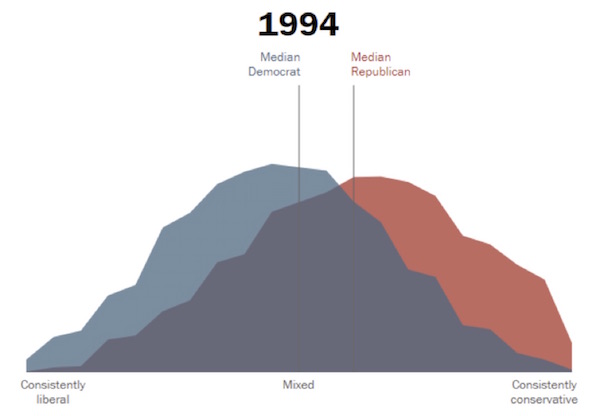
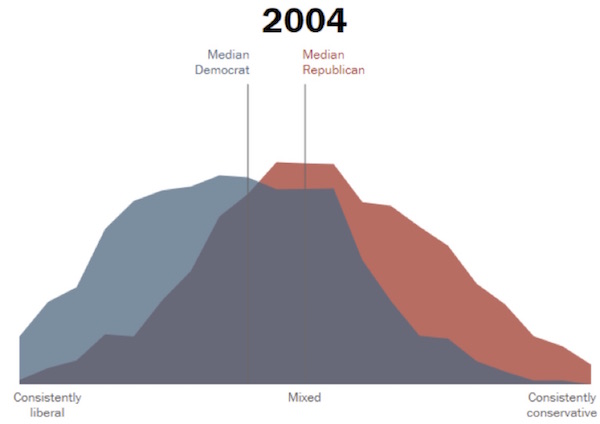
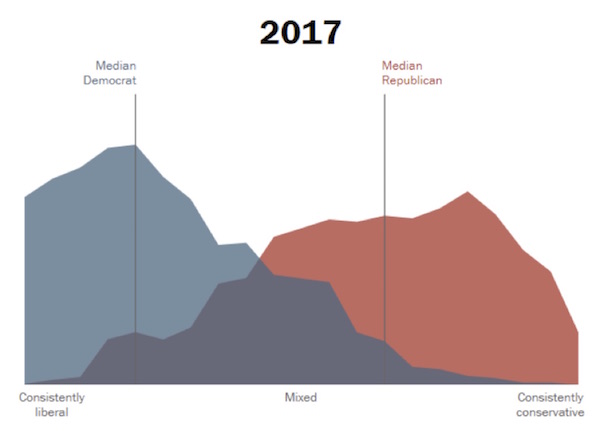
Not only are the median positions of both parties further apart, but both parties have also shifted farther to their respective extremes in the last 13 years. The middle ground is much smaller, and to my eye it looks like the Democratic group is somewhat bigger than the Republican. You can see the same thing in the breakdown of the vote by states and counties; but since political commentary is not my genre, I’m going to avoid going any further down that rabbit hole.
But I will say that the internet, social media, and the media we consume on TV have allowed us to live in echo chambers where we are not really hearing much from the other side. We talk to people who think like we do and who tend to confirm that we are correct in our beliefs. That constant cycle of reinforcement makes our positions even more hardline, to the point where we trivialize or disparage the other side. It has seemingly become acceptable for an American congressman to say that he doesn’t feel sorry for those killed in the mass Las Vegas shooting because they were likely Trump supporters and against gun control. And for white hate groups to blatantly and publicly espouse racist positions. Antifa groups can call for the random killing of white people, simply for being white. And fewer than 30% of Millennials think that democracy is clearly the superior system of government.
And that is where we are today. Where are we going to be when unemployment is well over 12% and rising to 15%, the government is routinely running multitrillion-dollar budget deficits, state and local pensions are defaulting, and taxes are high and still rising?
And all this is going to happen at a time when wealth and income disparity are going to rising even faster than they are today. It’s all there in the data if you take the time to look. I am working hard to document not just the technological changes but the social, demographic, and political changes, along with the economic realities we will face in the book I’m currently writing. My greatest challenge will be to keep it under 300 pages!
And so, yes, when people ask what is in my worry closet, it is the fragmentation of society. As a country, we are going to have to begin to think the unthinkable. We really don’t know how to accurately measure GDP or inflation, and we certainly don’t have any way to statistically measure the improvements in lifestyle over the years. And we will need those tools. As conservatives and Republicans, we are going to have to think about something like universal basic employment, as opposed to universal basic income. Good work and participating in society give us meaning in life. Income just gives us a way to scrape by, but not personal life satisfaction or meaning, which is why we have an epidemic of opioid deaths, suicides, and rising deaths from alcoholism in the United States among white unemployed workers between 45 and 54. They have lost meaning and hope in their lives.
The calls for a guaranteed basic income (like Mark Zuckerberg’s) are just beginning, but that is going to become a major political theme in our future. Like King Canute, we cannot stop the tides – but perhaps we could get creative and channel that tide. What do we think of shorter work weeks? Just as Roosevelt put men to work during the Depression, maybe we need to think about finding jobs around our communities that need to be done. Guaranteed basic employment. Mull that over….
Yes, that offends every Hayekian neuron in my brain, but in a world of an unimaginable and unmanageable future, we are going to have start thinking the unthinkable.
Voters are going to want politicians to solve their problems. Politicians can’t really solve the problems we already have, let alone the problems of the future, so I expect we are going to see shifts from one political extreme to the other.
Let’s be clear, these problems are not all going to show up next year, and most won’t even start to be understood until the early 2020s. But they’re coming, and we need to begin to plan for them now, for our country, for our own and our families’ lives, and for our portfolios. I look forward to being part of your journey and hopefully helping you to plan.
Denver, Lugano, and Hong Kong
On November 7, I will be speaking to the Denver CFA Society. I’m going to try to go to the Rice University homecoming that the following weekend, because there will be a special reception for former editors of the student newspaper. Editing the Rice Thresher is one of my fondest college memories and was a tremendous learning experience. Understand, we had no journalism classes and no faculty oversight. The paper was entirely student-run. The size of the paper depended on how many ads we sold. We were still printing the paper on an old letterpress with handset type. I was told by the printers that I was the first editor in 50 years who actually knew how to come in and set the time, run the presses, etc. I grew up in a print shop setting type and still have ink in my blood. The third-generation owners of the printing company that produced our paper had been printing the Thresher for over 50 years. They possessed a wealth of historical knowledge. At homecoming there will also be a public lecture by Dr. Vernon Smith, Nobel laureate and one of my personal economic heroes. Maybe I can even wrangle an invitation to dinner.
One week later I will fly to Lugano, Switzerland, for a presentation to a conference – and I’ll try not to push myself quite so hard on this next trip across the Pond. Shane and I will also be in Hong Kong for the Bank of America Merrill Lynch conference in early January.
This week has been one meeting after another and one call after another, and I still have 437 emails in my inbox. This letter is already too long, so I am going to hit the send button and push out my plan to share my Thanksgiving mushroom recipe to a future week.
One of the rarest commodities today is time to pay undivided attention to anything, and the fact that that you give me some of your attention is truly humbling. I know that most of you are just as busy as I am. I try to make my writing worth your time and to make you think. I know today’s letter has been a little on the dark side, but I tell you, we will figure out together how to Muddle Through. And I hope I can help you do much better than simply Muddle Through.
Have a great week. Take somebody with a different political view to lunch and have a sensible and agreeable conversation. Listen to other people’s perspectives and try to grasp what they’re saying. Maybe they will pass on the courtesy. Have a great week.
Your more optimistic about life and the future than ever analyst (even though the transition will be bumpy),

John Mauldin
subscribers@MauldinEconomics.com
Copyright 2017 John Mauldin. All Rights Reserved.
| Digg This Article
-- Published: Monday, 30 October 2017 | E-Mail | Print | Source: GoldSeek.com

